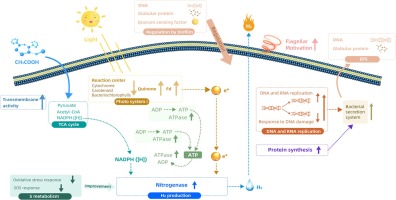当前位置:
X-MOL 学术
›
Environ. Int.
›
论文详情
Our official English website, www.x-mol.net, welcomes your
feedback! (Note: you will need to create a separate account there.)
Synthesized effects of proteomic and extracellular polymeric substance (EPS) revealing the enhanced hydrogen production by formed biofilm of photo-fermentative bacteria.
Environment International ( IF 10.3 ) Pub Date : 2020-03-31 , DOI: 10.1016/j.envint.2020.105683 Han-Quan Wen 1 , Hong-Yu Ren 1 , Guo-Jun Xie 1 , Guang-Li Cao 1 , De-Feng Xing 1 , Nan-Qi Ren 1 , Bing-Feng Liu 1
Environment International ( IF 10.3 ) Pub Date : 2020-03-31 , DOI: 10.1016/j.envint.2020.105683 Han-Quan Wen 1 , Hong-Yu Ren 1 , Guo-Jun Xie 1 , Guang-Li Cao 1 , De-Feng Xing 1 , Nan-Qi Ren 1 , Bing-Feng Liu 1
Affiliation

|
Photo-fermentative hydrogen production, the new energy production alternative, was greatly enhanced by formed biofilm. To understand the mechanism of enhancement, the intracellular proteome and extracellular polymeric substance (EPS)i during biofilm formation were investigated in this work. Experimental results indicated that a possible and effective altered system could transfer light to hydrogen. Proteins were significantly regulated, for example those related with nitrogenase, flagellin, EPS transportation and DNA duplication were up-regulated while those concerned photosystem were down-regulated. It revealed these changes of proteins contributed to positive activity of key enzymes, improved communication system and increased total light utilization efficiency thus leading to enhanced capacity of hydrogen production. Besides above metabolic changes inside the cells, EPS secreted by the bacteria played an important role in hydrogen production and its yield decided the release of hydrogen. When EPS descended to a lower concentration during biofilm formation, it meant carbon source for EPS synthesis was reduced, and more energy and reducing power could be transferred into hydrogen energy. More importantly, this work found that composition and structure of EPS were efficiently influenced by the formation of biofilm, such as benzene and O-H structure, secondary protein structure and the kinds of protein, which were important to stable biofilm and efficient hydrogen production. Therefore, final hydrogen yield was improved by altered protein and EPS resulted from biofilm formation. This study demonstrated that formation of biofilm is an efficient, ecological and attracting way to the future bio-hydrogen production.
中文翻译:

蛋白质组学和细胞外聚合物质(EPS)的合成效应揭示了光发酵细菌形成的生物膜增强了氢的产生。
通过形成的生物膜大大提高了光发酵制氢的能力,这是新能源的替代生产方式。为了了解增强的机制,在这项工作中研究了生物膜形成过程中的细胞内蛋白质组和细胞外聚合物(EPS)i。实验结果表明,一种可能有效的改变系统可以将光转换为氢。蛋白质被显着调节,例如,与固氮酶,鞭毛蛋白,EPS转运和DNA复制相关的蛋白被上调,而与光系统有关的蛋白被下调。它揭示了蛋白质的这些变化有助于关键酶的正活性,改善了通讯系统并提高了总光利用效率,从而提高了制氢能力。除了上述细胞内部的代谢变化外,细菌分泌的EPS在制氢中也起着重要作用,其产量决定了氢的释放。当生物膜形成过程中EPS降低至较低浓度时,这意味着用于EPS合成的碳源减少了,更多的能量和降低的功率可以转化为氢能。更重要的是,这项工作发现EPS的组成和结构受生物膜形成的有效影响,例如苯和OH结构,二级蛋白质结构和蛋白质种类,这对于稳定生物膜和有效制氢至关重要。因此,通过改变生物膜形成引起的蛋白质和EPS的变化,最终的氢产量得以提高。这项研究表明,生物膜的形成是一种有效的方法,
更新日期:2020-03-31
中文翻译:

蛋白质组学和细胞外聚合物质(EPS)的合成效应揭示了光发酵细菌形成的生物膜增强了氢的产生。
通过形成的生物膜大大提高了光发酵制氢的能力,这是新能源的替代生产方式。为了了解增强的机制,在这项工作中研究了生物膜形成过程中的细胞内蛋白质组和细胞外聚合物(EPS)i。实验结果表明,一种可能有效的改变系统可以将光转换为氢。蛋白质被显着调节,例如,与固氮酶,鞭毛蛋白,EPS转运和DNA复制相关的蛋白被上调,而与光系统有关的蛋白被下调。它揭示了蛋白质的这些变化有助于关键酶的正活性,改善了通讯系统并提高了总光利用效率,从而提高了制氢能力。除了上述细胞内部的代谢变化外,细菌分泌的EPS在制氢中也起着重要作用,其产量决定了氢的释放。当生物膜形成过程中EPS降低至较低浓度时,这意味着用于EPS合成的碳源减少了,更多的能量和降低的功率可以转化为氢能。更重要的是,这项工作发现EPS的组成和结构受生物膜形成的有效影响,例如苯和OH结构,二级蛋白质结构和蛋白质种类,这对于稳定生物膜和有效制氢至关重要。因此,通过改变生物膜形成引起的蛋白质和EPS的变化,最终的氢产量得以提高。这项研究表明,生物膜的形成是一种有效的方法,











































 京公网安备 11010802027423号
京公网安备 11010802027423号